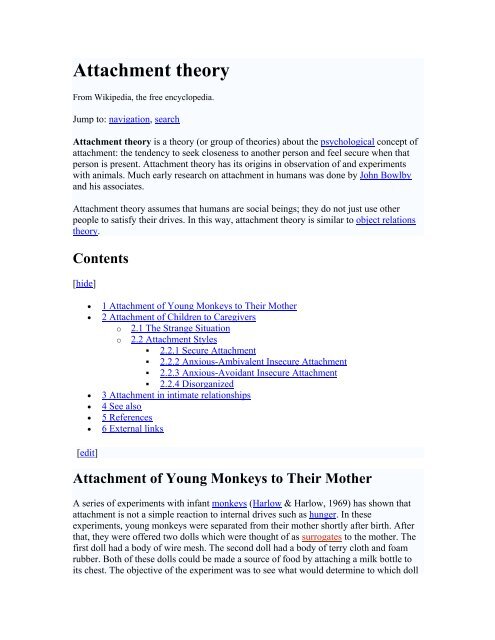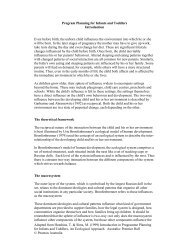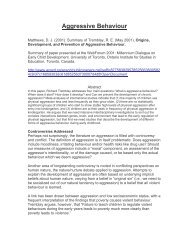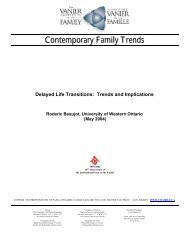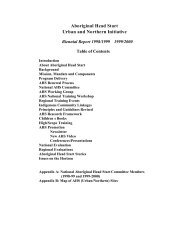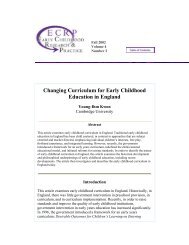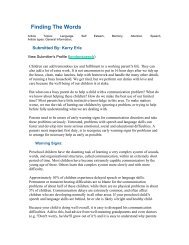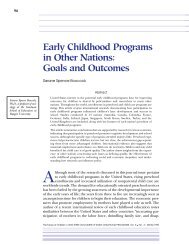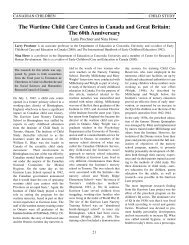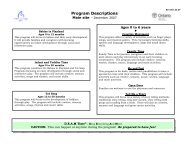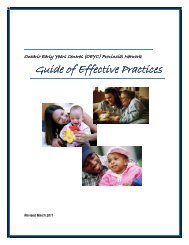Attachment theory - Peel Early Years
Attachment theory - Peel Early Years
Attachment theory - Peel Early Years
Create successful ePaper yourself
Turn your PDF publications into a flip-book with our unique Google optimized e-Paper software.
<strong>Attachment</strong> <strong>theory</strong><br />
From Wikipedia, the free encyclopedia.<br />
Jump to: navigation, search<br />
<strong>Attachment</strong> <strong>theory</strong> is a <strong>theory</strong> (or group of theories) about the psychological concept of<br />
attachment: the tendency to seek closeness to another person and feel secure when that<br />
person is present. <strong>Attachment</strong> <strong>theory</strong> has its origins in observation of and experiments<br />
with animals. Much early research on attachment in humans was done by John Bowlby<br />
and his associates.<br />
<strong>Attachment</strong> <strong>theory</strong> assumes that humans are social beings; they do not just use other<br />
people to satisfy their drives. In this way, attachment <strong>theory</strong> is similar to object relations<br />
<strong>theory</strong>.<br />
Contents<br />
[hide]<br />
• 1 <strong>Attachment</strong> of Young Monkeys to Their Mother<br />
• 2 <strong>Attachment</strong> of Children to Caregivers<br />
o 2.1 The Strange Situation<br />
o<br />
2.2 <strong>Attachment</strong> Styles<br />
• 2.2.1 Secure <strong>Attachment</strong><br />
• 2.2.2 Anxious-Ambivalent Insecure <strong>Attachment</strong><br />
• 2.2.3 Anxious-Avoidant Insecure <strong>Attachment</strong><br />
• 2.2.4 Disorganized<br />
• 3 <strong>Attachment</strong> in intimate relationships<br />
• 4 See also<br />
• 5 References<br />
• 6 External links<br />
[edit]<br />
<strong>Attachment</strong> of Young Monkeys to Their Mother<br />
A series of experiments with infant monkeys (Harlow & Harlow, 1969) has shown that<br />
attachment is not a simple reaction to internal drives such as hunger. In these<br />
experiments, young monkeys were separated from their mother shortly after birth. After<br />
that, they were offered two dolls which were thought of as surrogates to the mother. The<br />
first doll had a body of wire mesh. The second doll had a body of terry cloth and foam<br />
rubber. Both of these dolls could be made a source of food by attaching a milk bottle to<br />
its chest. The objective of the experiment was to see what would determine to which doll
the monkey would cling: the soft contact of the cloth or the source of food. It turned out<br />
that the monkeys would cling to the soft-clothed doll, irrespective of whether it provided<br />
food. The monkeys were also more exploring when the soft-cloth doll was near.<br />
Apparently, the doll provided them with a sense of security. However, the passive doll<br />
was not an adequate alternative for a real mother. Infant monkeys which were raised<br />
without contact with other monkeys showed abnormal behavior in social situations. They<br />
were either very fearful of other monkeys or responded with unprovoked aggression<br />
when they encountered other monkeys. There also showed abnormal sexual responses.<br />
Female monkeys who were raised in isolation often neglected or abused their infants.<br />
This abnormal behaviour is thought to demonstrate that a bond with the mother is<br />
necessary for further social development.<br />
[edit]<br />
<strong>Attachment</strong> of Children to Caregivers<br />
<strong>Attachment</strong> <strong>theory</strong> led not only to increased attention to attachments as a psychosocial<br />
process, it also led to a new understanding of child development. Freudian <strong>theory</strong><br />
suggested that as libidinal drives fixed on different objects, former attachments would be<br />
broken; failure to break an attachment effectively would constitute a sort of trauma that<br />
could lead to later mental illness. <strong>Attachment</strong> <strong>theory</strong>, however, suggested that growing<br />
children did not break former attachments, but rather (1) learned to become more active<br />
(or sovereign) within previously established attachments, and (2) added new attachments,<br />
which did not necessarily require a break with (and are not necessarily substitutes for)<br />
previous attachments.<br />
[edit]<br />
The Strange Situation<br />
Mary Ainsworth is a developmental psychologist who devised a procedure, called The<br />
Strange Situation, to observe attachment relationships between a human caregiver and<br />
child. In this procedure the child is observed playing for 20 minutes while caregivers and<br />
strangers enter and leave the room, recreating the flow of the familiar and unfamiliar<br />
presence in most children's lives. The situation varies in stressfulness and the child's<br />
responses are observed. The child experiences the following situations:<br />
1. Parent and infant are introduced to the experimental room.<br />
2. Parent and infant are alone. Parent does not participate while infant explores.<br />
3. Stranger enters, converses with parent, then approaches infant. Parent leaves<br />
inconspicuously.<br />
4. First separation episode: Stranger's behavior is geared to that of infant.<br />
5. First reunion episode: Parent greets and comforts infant, then leaves again.<br />
6. Second separation episode: Infant is alone.
7. Continuation of second separation episode: Stranger enters and gears behavior to<br />
that of infant.<br />
8. Second reunion episode: Parent enters, greets infant, and picks up infant; stranger<br />
leaves inconspicuously.<br />
Two aspects of the child's behaviour are observed:<br />
1. The amount of exploration (e.g. playing with new toys) the child engages in<br />
throughout.<br />
2. The child's reactions to the departure and return of its caregiver.<br />
[edit]<br />
<strong>Attachment</strong> Styles<br />
On the basis of their behaviours, the children can be categorized into three groups. Each<br />
of these groups reflects a different kind of attachment relationship with the mother. (It<br />
should be noted that Bowlby believed that mothers were the primary attachment figure in<br />
children's lives, but subsequent research has confirmed that children form attachments to<br />
both their mothers and their fathers. Bowlby, like many of his colleagues at the time,<br />
infused the gender norms of the day into otherwise "unbiased" scientific research).<br />
[edit]<br />
Secure <strong>Attachment</strong><br />
A child who is securely attached to its mother will explore freely while the mother is<br />
present, will engage with strangers, will be visibly upset when the mother departs, and<br />
happy to see the mother return.<br />
Securely attached children are best able to explore when they have the knowledge of a<br />
secure base to return to in times of need (also known as "rapprochement", meaning in<br />
French "bring together"). When assistance is given, this bolsters the sense of security and<br />
also, assuming the mother's assistance is helpful, educates the child in how to cope with<br />
the same problem in the future. Therefore, secure attachment can be seen as the most<br />
adaptive attachment style. According to some psychological researchers, a child becomes<br />
securely attached when the mother is available and able to meet the needs of the child in<br />
a responsive and appropriate manner. Others have pointed out that there are also other<br />
determinants of the child's attachment, and that behavior of the parent may in turn be<br />
influenced by the child's behaviour.<br />
[edit]<br />
Anxious-Ambivalent Insecure <strong>Attachment</strong>
A child with an anxious-resistant attachment style is anxious of exploration and of<br />
strangers, even when the mother is present. When the mother departs, the child is<br />
extremely distressed. The child will be ambivalent when she returns - seeking to remain<br />
close to the mother but resentful, and also resistant when the mother initiates attention.<br />
According to some psychological researchers, this style develops from a mothering style<br />
which is engaged but on the mother's own terms. That is, sometimes the child's needs are<br />
ignored until some other activity is completed and that attention is sometimes given to the<br />
child more through the needs of the parent than from the child's initiation.<br />
[edit]<br />
Anxious-Avoidant Insecure <strong>Attachment</strong><br />
A child with an anxious-avoidant attachment style will avoid or ignore the mother -<br />
showing little emotion when the mother departs or returns. The child will not explore<br />
very much regardless of who is there. Strangers will not be treated much differently from<br />
the mother. There is not much emotional range displayed regardless of who is in the room<br />
or if it is empty.<br />
This style of attachment develops from a mothering style which is more disengaged. The<br />
child's needs are frequently not met and the child comes to believe that communication of<br />
needs has no influence on the mother.<br />
[edit]<br />
Disorganized<br />
There is also a fourth category termed Disorganized <strong>Attachment</strong>. It would be wrong to<br />
call Disorganized <strong>Attachment</strong> a style as it is the lack of a coherent style or pattern for<br />
coping. While Ambivalent and Avoidant styles are not totally effective, they are<br />
strategies for dealing with the world. Children with disorganized attachment experienced<br />
their caregivers as both frightened and frightening. Human interactions are experienced<br />
as erratic, thus children cannot form a coherent interactive template. If the child uses the<br />
caregiver as a mirror to understand the self; the disorganized child is looking into a<br />
mirror broken into a thousand pieces. It is more severe than learned helplessness as it is<br />
the model of the self rather than of a situation.<br />
[edit]<br />
<strong>Attachment</strong> in intimate relationships<br />
Building on the work of John Bowlby and Mary Ainsworth, other researchers have<br />
detected similar patterns of behavior in adult relations with romantic partners and<br />
spouses. Securely attached people are able to place trust in their partner which, in turn,<br />
means they can confidently spend time apart. People with an anxious ambivalent
attachment style may have difficulties because their way of behaving in relationships can<br />
be seen as needy or clingy by their partner. They are prone to worry about whether their<br />
partner loves them or whether they are valued by their partner. People with an avoidant<br />
attachment style are uncomfortable being close to others. They have difficulties in<br />
trusting other people and do not like to depend on others.<br />
Such patterns are believed to develop in infancy, but can be modified as people enter into<br />
new relationships.<br />
[edit]<br />
See also<br />
• Mary Ainsworth<br />
• Erik Erikson<br />
• John Bowlby<br />
• Melanie Klein<br />
• Jerome Kagan<br />
• Jean Piaget<br />
• Sigmund Freud<br />
• Object relations <strong>theory</strong><br />
[edit]<br />
References<br />
• Harlow, H. F. & Harlow, M. K. (1969) Effects of various mother-infant<br />
relationships on rhesus monkey behaviors. In B. M. Foss (Ed.) Determinants of<br />
infant behavior (Vol.4). London: Methuen.<br />
• Holmes, J. (1993) John Bowlby and <strong>Attachment</strong> Theory. Routledge; ISBN<br />
0415077303<br />
• Holmes, J. (2001) The Search for the Secure Base: <strong>Attachment</strong> Theory and<br />
Psychotherapy; Brunner-Routledge; ISBN 1583911529


